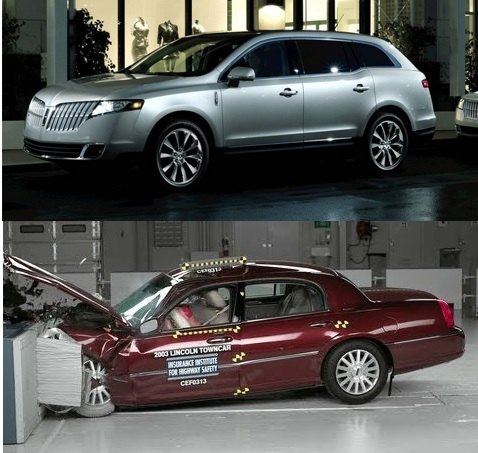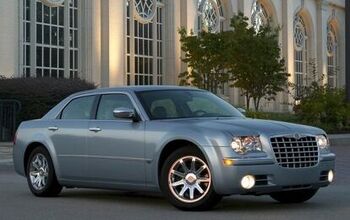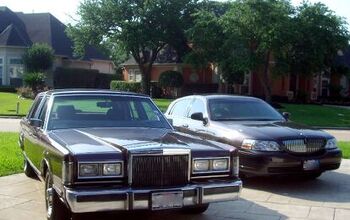Doug's Comparison: Lincoln MKT Vs. Lincoln Town Car

I recently wrote an article entitled “ Lincoln Can and Will Come Back,” in which I insisted that Lincoln would, someday soon, rise from the ashes and return to its rightful place as a top luxury brand for people who can’t afford an Infiniti. Many of you thought I was crazy, largely because Lincoln’s lineup consists of five re-skinned Fords, all of which share the same name.
But as a patriotic American, I am certain that Lincoln will come back. In fact, I believe its resurgence has already begun, as I will illustrate with a comparison between the Town Car and the MKT. I know what you’re thinking: Why are you comparing the Town Car with a … wait, what the hell is an MKT? Is that a sedan? The answer is: because that’s what Lincoln is doing. You see, Lincoln is telling current Town Car drivers – in other words, airport limo services and Jack Baruth – that the MKT is the Town Car’s rightful replacement. Also, the MKT is not a sedan, but rather a medium-sized hearse that Lincoln calls a crossover.
So let’s see how it stacks up in a comparison.
Interior Room
This is an important category, since the Town Car’s main purpose is shuttling passengers to and from the airport while the driver talks on a cell phone. Let’s start with rear head room. The Town Car has just 37.6 inches, while the MKT boasts a whopping 39 inches. This is wonderful. The last time I was in a Town Car, all I could think was: I fit perfectly, but I cannot comfortably stand a USB stick on my head. That problem is eliminated in the MKT.
Moving on to rear leg room, the Town Car claims 41.1 inches, while the MKT offers 41.8. And point seven inches, ladies and gentlemen, could mean the difference between fully extending your foot and keeping it at a slightly uncomfortable angle. Advantage: MKT. (To anyone eager to remind me that the Town Car offers a stretched wheelbase version with 46.9 inches of leg room, I can only ask: why do you hate America?)
Efficiency
Efficiency is an important category because, as airport limos, the Town Car and MKT will often be left idling for hours in airport parking lots while the driver talks to other airport limo drivers. Also, they will occasionally be driven.
You might think this gives the Town Car an advantage, since the MKT is a truck that weighs as much as a college football stadium. But you’d be wrong. That’s because the fleet-only version of the MKT – dubbed the MKT Town Car in an homage to its fallen comrade – offers a turbocharged four-cylinder engine that isn’t available to the general public. It makes 230 horsepower, which is only nine less than the Town Car’s 4.6-liter V8. And, at 20 mpg city and 28 highway, it’s far more efficient than the Town Car’s 17/25. Advantage: MKT. (Note: this category isn’t called “acceleration.”)
Nimbleness
The few Town Cars that aren’t in airport limo service are being driven, rather rapidly, through New York City. As a result, it’s important that Town Car and MKT be light on their feet, which they aren’t. But there are some interesting statistics I must share, which may, for a second, make you think you’re actually reading a legitimate comparison. This is, of course, not true.
Number one: length. The base-level Town Car is 215 inches long. The Town Car L is 221.4 inches long. The MKT, meanwhile, comes in at a spry 207.6 inches. This is a massive difference that strikes me as sort of like comparing a potted plant to a dump truck.
It gets better for the MKT. At 76 inches, the MKT is actually 2.2 inches narrower than the Town Car. And it loses the turning circle comparison by two measly feet. Since that goes against my argument, I will decry it as virtually meaningless. In other words: compared to the Town Car, the MKT is basically a Miata. Advantage: MKT.
Resemblance to a Hearse
Like the windshield wiper normalcy showdown in my LEAF vs. Fit comparison, this is an important category that is far too often overlooked by traditional automotive journalists. Of course, there’s no real comparison: the Town Car looks like a sedan, possibly from the 1980s, while the MKT looks exactly like a hearse. This is especially true of the hearse model. Advantage: MKT.
Pricing
I have to admit, I thought the Town Car would easily win this category. That’s because I, like you, haven’t looked up Lincoln Town Car pricing since the Clinton era, when the Town Car cost $19,500 and had a vertical rear window. Things have changed since then. What do you expect the Town Car’s base price was in its final model year? $30,000? $40,000? The answer is, with shipping: forty-eight thousand dollars. And that’s before options, which include luxuries like a trunk organizer.
The MKT, meanwhile, starts at a mere $46,000, and presumably far less for the four-cylinder version, which – let’s be honest – is probably incredibly slow and resembles a hearse. Also, the MKT is probably loaded with incentives, which may even include a free trunk organizer. Advantage: MKT.
Conclusion
Clearly, there is no comparison between the Town Car and the MKT: one is an outdated, body-on-frame sedan, and the other is a brilliant crossover with a voluminous interior and a 2-liter four-cylinder that also powers the Ford Focus. Therefore, I am happy to announce that the MKT heralds in the era of Lincoln Motor Company. It just does it very, very slowly, and possibly with a casket in back.
Doug DeMuro operates PlaysWithCars.com. He’s owned an E63 AMG wagon, road-tripped across the US in a Lotus without air conditioning, and posted a six-minute lap time on the Circuit de Monaco in a rented Ford Fiesta. One year after becoming Porsche Cars North America’s youngest manager, he quit to become a writer. His parents are very disappointed.

More by Doug DeMuro
Latest Car Reviews
Read moreLatest Product Reviews
Read moreRecent Comments
- Theflyersfan OK, I'm going to stretch the words "positive change" to the breaking point here, but there might be some positive change going on with the beaver grille here. This picture was at Car and Driver. You'll notice that the grille now dives into a larger lower air intake instead of really standing out in a sea of plastic. In darker colors like this blue, it somewhat conceals the absolute obscene amount of real estate this unneeded monstrosity of a failed styling attempt takes up. The Euro front plate might be hiding some sins as well. You be the judge.
- Theflyersfan I know given the body style they'll sell dozens, but for those of us who grew up wanting a nice Prelude Si with 4WS but our student budgets said no way, it'd be interesting to see if Honda can persuade GenX-ers to open their wallets for one. Civic Type-R powertrain in a coupe body style? Mild hybrid if they have to? The holy grail will still be if Honda gives the ultimate middle finger towards all things EV and hybrid, hides a few engineers in the basement away from spy cameras and leaks, comes up with a limited run of 9,000 rpm engines and gives us the last gasp of the S2000 once again. A send off to remind us of when once they screamed before everything sounds like a whirring appliance.
- Jeff Nice concept car. One can only dream.
- Funky D The problem is not exclusively the cost of the vehicle. The problem is that there are too few use cases for BEVs that couldn't be done by a plug-in hybrid, with the latter having the ability to do long-range trips without requiring lengthy recharging and being better able to function in really cold climates.In our particular case, a plug-in hybrid would run in all electric mode for the vast majority of the miles we would drive on a regular basis. It would also charge faster and the battery replacement should be less expensive than its BEV counterpart.So the answer for me is a polite, but firm NO.
- 3SpeedAutomatic 2012 Ford Escape V6 FWD at 147k miles:Just went thru a heavy maintenance cycle: full brake job with rotors and drums, replace top & bottom radiator hoses, radiator flush, transmission flush, replace valve cover gaskets (still leaks oil, but not as bad as before), & fan belt. Also, #4 fuel injector locked up. About $4.5k spread over 19 months. Sole means of transportation, so don't mind spending the money for reliability. Was going to replace prior to the above maintenance cycle, but COVID screwed up the market ( $4k markup over sticker including $400 for nitrogen in the tires), so bit the bullet. Now serious about replacing, but waiting for used and/or new car prices to fall a bit more. Have my eye on a particular SUV. Last I checked, had a $2.5k discount with great interest rate (better than my CU) for financing. Will keep on driving Escape as long as A/C works. 🚗🚗🚗





































Comments
Join the conversation
I think Doug missed one of the most important qualities for a vehicle used for shuttling one about: ride quality. And the Town Car wins hands down. As far as interior space, the "L" edition of the Town car has about SIX more inches of legroom than an MKT. Funny you missed that, Doug...since you had mentioned the "L" but only as it pertained to handling and wheelbase. I've been shuttled to the airport for work and often have both cars shuttle me in the same day. I prefer the Town Car hands down. Better ride quality, no rattles and because of that...quieter more serene ride. Oh..and another thing..the drivers said the Town Car is cheaper to service and parts are cheaper than the MKT. Definitely an important consideration if you're the operator. I'll take a Town Car every time.
If I might add... http://i188.photobucket.com/albums/z256/jimbob1955_2007/LLL/leavelincolnalone_zpsc9810035.png